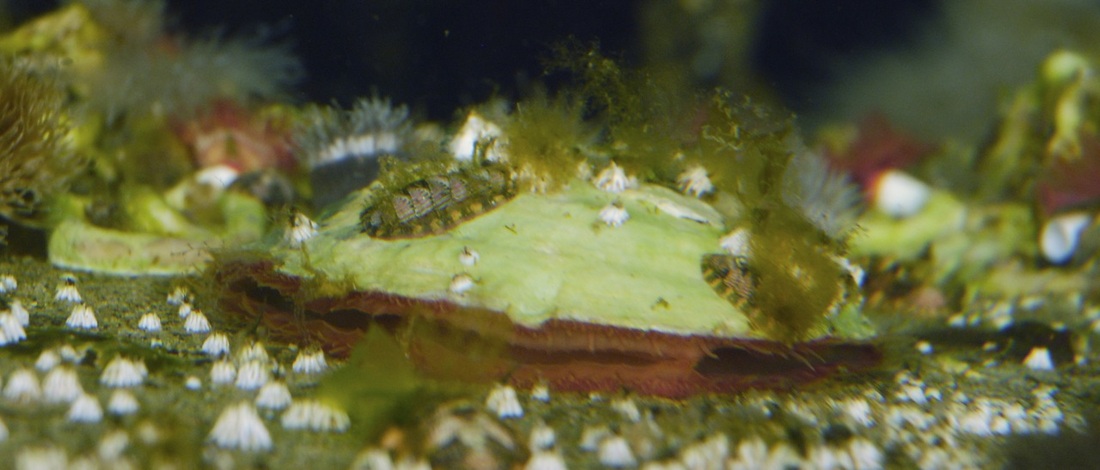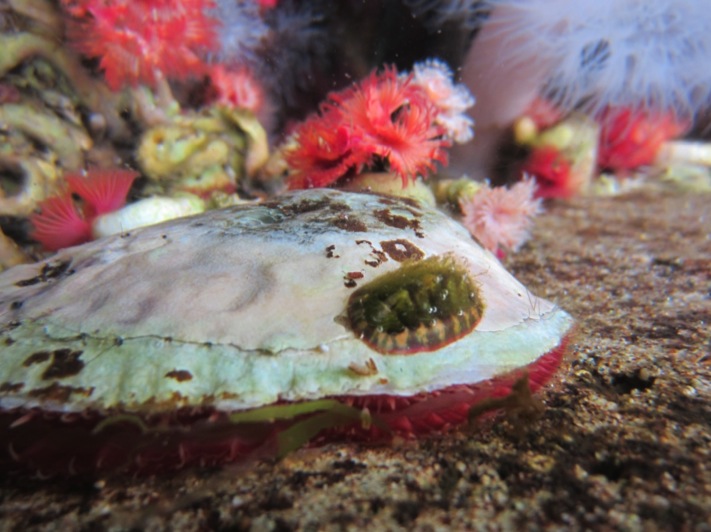Green false-jingle, rock oyster, jingle shell • Pododesmus macrochisma
{Jingle shell = from the musical jingling the empty shells make when struck together}
Green false jingle attatched to the Hakai Institute docks. Photos by Kelly Fretwell (top), Nathaniel Glickman (left), and Kate Adams (right)
Identification
The green false-jingle has the appearance of a flattened clam. It has two asymmetrical greyish-white shells. The upper shell is whole and circular, with a low curve, while the lower shell is flatter and has a pear-shaped hole near the hinge through which the jingle attaches itself to a substrate. The upper shell is marked with light radiating lines and shapes itself to its substrate, and the interior of both shells is polished and an iridescent green colour. The false-jingle's flesh is a vivid orange-red colour. It grows to 13 cm in diameter.
Habitat & Range
The green false-jingle attaches to solid substrates like rocks, docks, and pilings, and can be found from the intertidal zone to a depth of 90 m. It is particularly common in low-current areas. Its range stretches from the Bering Sea to Baja California and into the Gulf of California.
Human Uses
Empty green false-jingle shells are sometimes strung up to make wind chimes, due to the musical sound the shells make when struck together.
Intriguing Info
The painted star and the mottled star both prey upon the green false-jingle.
iNaturalist
https://www.inaturalist.org/taxa/68652-Pododesmus-macrochisma
The green false-jingle has the appearance of a flattened clam. It has two asymmetrical greyish-white shells. The upper shell is whole and circular, with a low curve, while the lower shell is flatter and has a pear-shaped hole near the hinge through which the jingle attaches itself to a substrate. The upper shell is marked with light radiating lines and shapes itself to its substrate, and the interior of both shells is polished and an iridescent green colour. The false-jingle's flesh is a vivid orange-red colour. It grows to 13 cm in diameter.
Habitat & Range
The green false-jingle attaches to solid substrates like rocks, docks, and pilings, and can be found from the intertidal zone to a depth of 90 m. It is particularly common in low-current areas. Its range stretches from the Bering Sea to Baja California and into the Gulf of California.
Human Uses
Empty green false-jingle shells are sometimes strung up to make wind chimes, due to the musical sound the shells make when struck together.
Intriguing Info
The painted star and the mottled star both prey upon the green false-jingle.
iNaturalist
https://www.inaturalist.org/taxa/68652-Pododesmus-macrochisma
References
Cowles, D. (2005). Pododesmus macroschisma (Gray, 1850). Invertebrates of the Salish Sea. Rosario Beach Marine Laboratory. Accessed 28/01/2014.
Harbo, R. M. (1999). Whelks to whales: Coastal marine life of the Pacific Northwest. Madeira Park, BC: Harbour Publishing. P. 90
Lamb, A., and Hanby, B. (2005). Marine Life of the Pacific Northwest [electronic resource]. Madeira Park, BC: Harbour Publishing.
Authors and editors of page
Kelly Fretwell and Brian Starzomski (2014).
Cowles, D. (2005). Pododesmus macroschisma (Gray, 1850). Invertebrates of the Salish Sea. Rosario Beach Marine Laboratory. Accessed 28/01/2014.
Harbo, R. M. (1999). Whelks to whales: Coastal marine life of the Pacific Northwest. Madeira Park, BC: Harbour Publishing. P. 90
Lamb, A., and Hanby, B. (2005). Marine Life of the Pacific Northwest [electronic resource]. Madeira Park, BC: Harbour Publishing.
Authors and editors of page
Kelly Fretwell and Brian Starzomski (2014).







